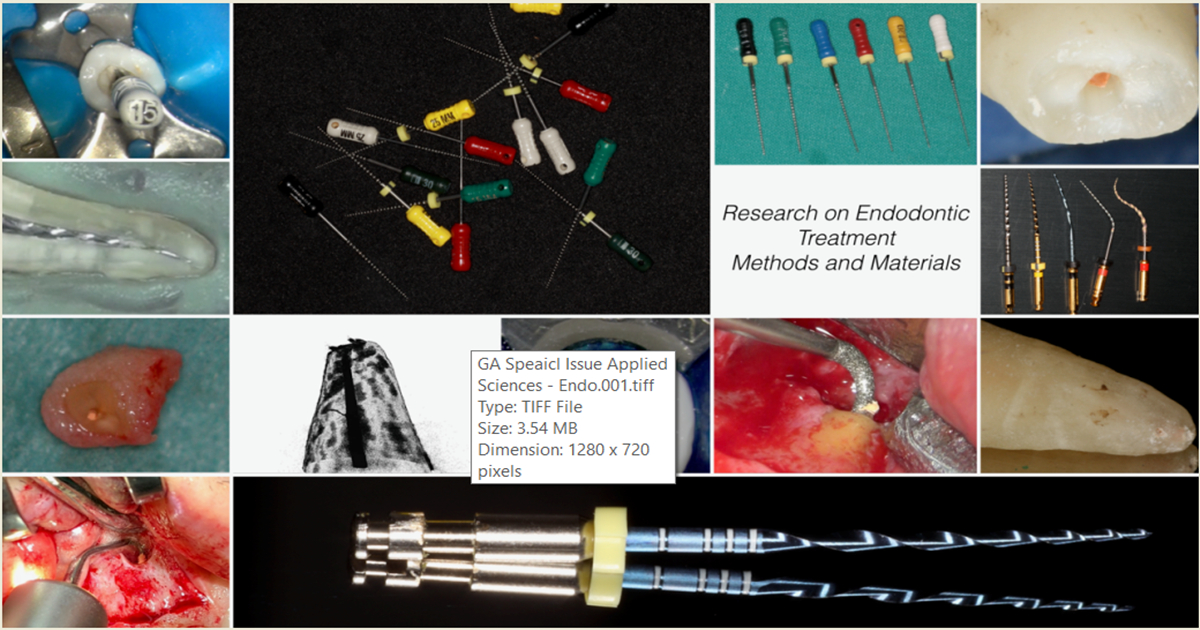Research on Endodontic Treatment Methods and Materials
A special issue of Applied Sciences (ISSN 2076-3417). This special issue belongs to the section "Applied Dentistry and Oral Sciences".
Deadline for manuscript submissions: closed (20 March 2025) | Viewed by 31518

Special Issue Editors
Interests: endodontic microsurgery
Special Issues, Collections and Topics in MDPI journals
Interests: resin composite; fiber-reinforced composite; root canal-treated teeth; fracture resistance; direct restoration; adhesive restoration
Special Issues, Collections and Topics in MDPI journals
Special Issue Information
Dear Colleagues,
The first two decades of the 21st century have seen spectacular developments in the dental sciences and related technologies, which have also transformed the way we think of endodontics. What was once not much more than root canal treatment is now an entire complex subdiscipline of dentistry equipped with an armamentarium of the latest technologies, including surgical microscopes, high-resolution digital imaging and computer-assisted guided surgery tailored to the individual patient’s needs. This development offers the practitioner an ever-growing set of tools to save patients’ teeth with ever-growing success rates.
This Special Issue aims to provide an overview of the latest research in endodontics and endodontic surgery, from bench science to chairside and clinical studies. The Special Issue features studies that can further our understanding of the latest issues and developments in the field and help the readers familiarize themselves with the state of the art in endodontics.
Topics of potential interest include (the list is not exhaustive):
- Static and dynamic navigation in endodontic surgery;
- The role and accuracy of digital (CBCT) imaging in endodontics;
- The advantages and limitations of new technologies;
- Success and survival in endodontics;
- Materials and material-related issues;
- Preclinical research regarding emerging endodontic techniques.
Dr. Márk Antal
Dr. Márk Fráter
Guest Editors
Manuscript Submission Information
Manuscripts should be submitted online at www.mdpi.com by registering and logging in to this website. Once you are registered, click here to go to the submission form. Manuscripts can be submitted until the deadline. All submissions that pass pre-check are peer-reviewed. Accepted papers will be published continuously in the journal (as soon as accepted) and will be listed together on the special issue website. Research articles, review articles as well as short communications are invited. For planned papers, a title and short abstract (about 250 words) can be sent to the Editorial Office for assessment.
Submitted manuscripts should not have been published previously, nor be under consideration for publication elsewhere (except conference proceedings papers). All manuscripts are thoroughly refereed through a single-blind peer-review process. A guide for authors and other relevant information for submission of manuscripts is available on the Instructions for Authors page. Applied Sciences is an international peer-reviewed open access semimonthly journal published by MDPI.
Please visit the Instructions for Authors page before submitting a manuscript. The Article Processing Charge (APC) for publication in this open access journal is 2400 CHF (Swiss Francs). Submitted papers should be well formatted and use good English. Authors may use MDPI's English editing service prior to publication or during author revisions.
Keywords
- endodontics
- endodontic surgery
- static guidance
- dynamic guidance
- endodontic anatomy
- periapical anatomy
- precision of endodontic interventions
- success of endodontic interventions
Benefits of Publishing in a Special Issue
- Ease of navigation: Grouping papers by topic helps scholars navigate broad scope journals more efficiently.
- Greater discoverability: Special Issues support the reach and impact of scientific research. Articles in Special Issues are more discoverable and cited more frequently.
- Expansion of research network: Special Issues facilitate connections among authors, fostering scientific collaborations.
- External promotion: Articles in Special Issues are often promoted through the journal's social media, increasing their visibility.
- Reprint: MDPI Books provides the opportunity to republish successful Special Issues in book format, both online and in print.
Further information on MDPI's Special Issue policies can be found here.






